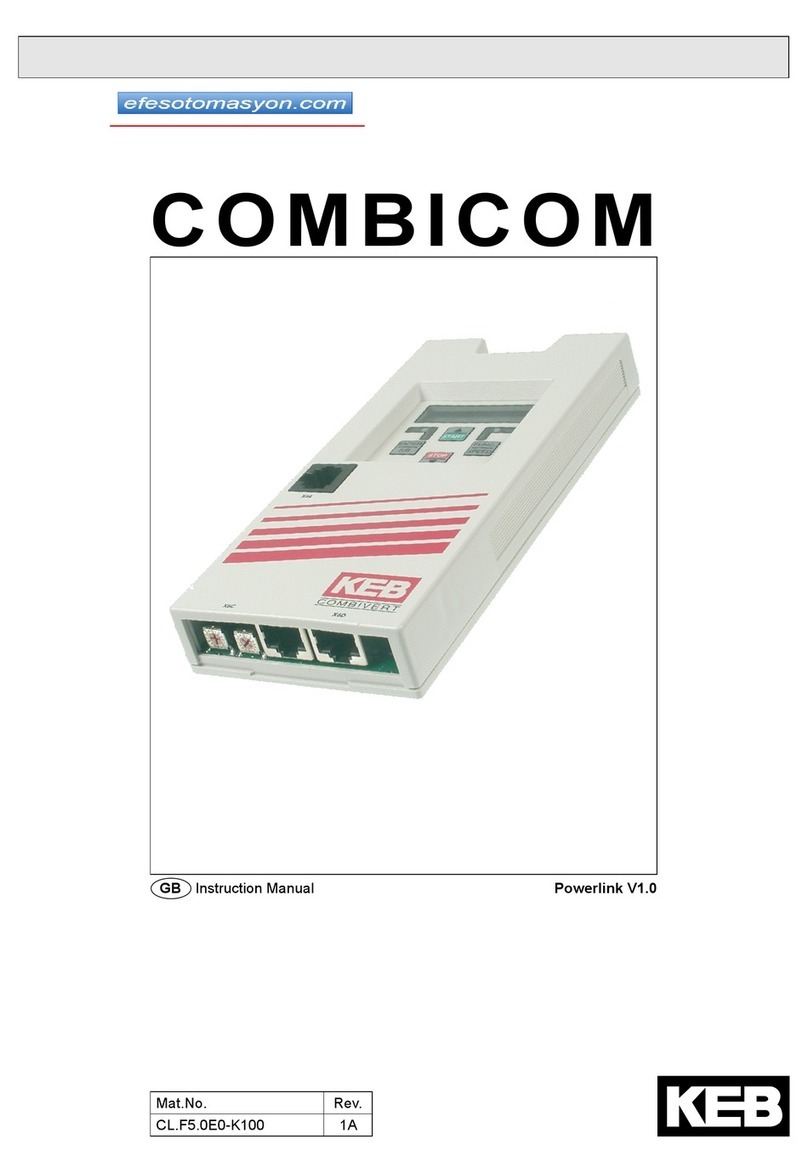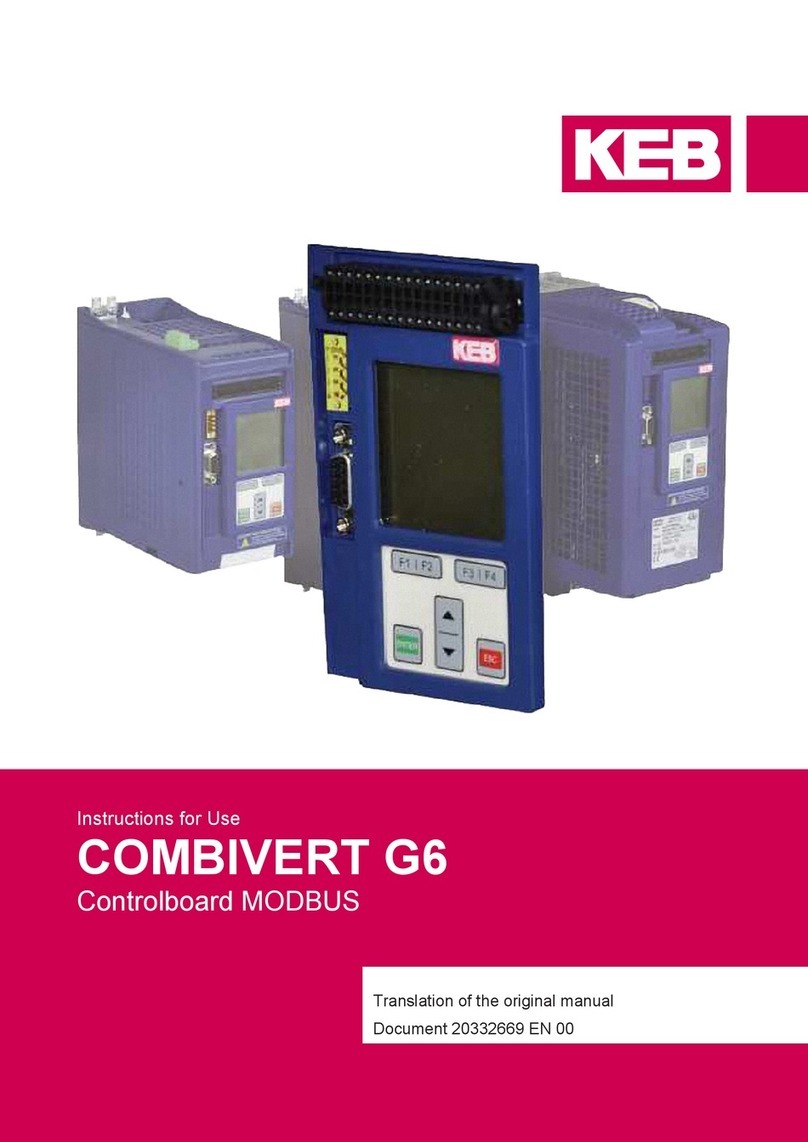KEBCO COMBISTOP 28 User manual

COMBISTOP TYPE 28
INSTRUCTIONS FOR USE | INSTALLATION
Translation of the original manual
Document 20193433 EN 02


3
PREFACE
Preface
The described hard- and software are developments of the KEB Automation KG. The
enclosed documents correspond to conditions valid at printing. Misprint, mistakes and
technical changes reserved.
Signal words and symbols
Certain operations can cause hazards during the installation, operation or thereafter.
There are safety informations in the documentation in front of these operations. Security
signs are located on the device or machine. A warning contains signal words which are
explained in the following table:
DANGER Dangerous situation, which will cause death or serious injury in case of
non-observance of this safety instruction.
WARNING Dangerous situation, which may cause death or serious injury in case of
non-observance of this safety instruction.
CAUTION Dangerous situation, which may cause minor injury in case of non-ob-
servance of this safety instruction.
NOTICE Situation, which can cause damage to property in case of non-obser-
vance.
RESTRICTION
Is used when certain conditions must meet the validity of statements or the result is
limited to a certain validity range.
Is used when the result will be better, more economic or trouble-free by following
these procedures.
More symbols
► Thisarrowstartsanactionstep.
• / - Enumerations are marked with dots or indents.
=> Cross reference to another chapter or another page.
Note to further documentation.
www.keb.de/service/downloads

4
PREFACE
Laws and guidelines
KEBAutomationKGconrmswiththeECdeclarationofconformityandtheCEmarkon
the device nameplate that it complies with the essential safety requirements.
The EC declaration of conformity can be downloaded on demand via our website. Fur-
therinformationisprovidedinchapter"Certication".
Warranty and liability
The warranty and liability on design, material or workmanship for the acquired device is
given in the general sales conditions.
Hereyouwillndourgeneralsalesconditions.
www.keb.de/terms-and-conditions
Furtheragreementsorspecicationsrequireawrittenconrmation.
Support
Through multiple applications not every imaginable case has been taken into ac-
count. If you require further information or if problems occur which are not treated de-
tailed in the documentation, you can request the necessary information via the local
KEB Automation KG agency.
The use of our units in the target products is outside of our control and therefore
lies exclusively in the area of responsibility of the customer.
Theinformationcontainedinthetechnicaldocumentation,aswellasanyuser-specic
advice in spoken and written and through tests, are made to best of our knowledge and
information about the intended use. However, they are regarded as being only informal
and changes are expressly reserved, in particular due to technical changes. This also
applies to any violation of industrial property rights of a third-party. Selection of our units
in view of their suitability for the intended use must be done generally by the user.
Tests can only be done within the intended end use of the product (application) by
the customer. They must be repeated, even if only parts of hardware, software or
the unit adjustment are modied.
Copyright
The customer may use the instructions for use as well as further documents or parts
from it for internal purposes. Copyrights are with KEB Automation KG and remain valid
in its entirety.
This KEB product or parts thereof may contain third-party software, including free and/
or open source software. If applicable, the license terms of this software are contained
in the instructions for use. The instructions for use are already available to you, can be
downloaded free of charge from the KEB website or can be requested from the respec-
tive KEB contact person.
Other wordmarks or/and logos are trademarks (™) or registered trademarks (®) of their
respective owners.

5
TABLE OF CONTENTS
Table of Contents
Preface ....................................................................................................................................................3
Signal words and symbols .............................................................................................................3
More symbols.................................................................................................................................3
Laws and guidelines.......................................................................................................................4
Warranty and liability......................................................................................................................4
Support ........................................................................................................................................4
Copyright........................................................................................................................................4
Table of Contents ...................................................................................................................................5
List of Figures.........................................................................................................................................7
List of Tables ..........................................................................................................................................7
Glossary ..................................................................................................................................................8
Standards for mechanical components ............................................................................................... 9
1 Basic Safety Instructions............................................ 10
1.1 Target group...................................................................................................................................10
1.2 Transport, storage and proper use .............................................................................................. 10
1.3 Installation and mounting............................................................................................................. 11
1.4 Electrical Connection.................................................................................................................... 11
1.5 Start-up and operation ..................................................................................................................12
1.6 Maintenance...................................................................................................................................13
1.7 Disposal..........................................................................................................................................13
2 Product description..................................................... 14
2.1 Intended use ..................................................................................................................................14
2.2 Residual risks ................................................................................................................................14
2.3 Improper use..................................................................................................................................14
2.4 Type code .......................................................................................................................................15
2.5 Overview/Parts List .......................................................................................................................16
2.6 Functional description ..................................................................................................................16
2.7 Options ...........................................................................................................................................17
2.7.1 Micro switch........................................................................................................................17
3 Technical Data.............................................................. 18
3.1 Operating conditions ....................................................................................................................18
3.1.1 Climatic environmental conditions......................................................................................18
3.1.2 Mechanical environmental conditions ................................................................................18
3.1.3 Electrical operating conditions............................................................................................18
3.2 Device data COMBISTOP 28......................................................................................................... 19
3.2.1 Overview ............................................................................................................................19
3.3 Dimensions and weights ..............................................................................................................20
3.3.1 Version without options ......................................................................................................20
3.3.2 Version for/with shaft sealing ring.......................................................................................21

6
TABLE OF CONTENTS
3.3.3 Version with hand release ..................................................................................................22
3.3.4 Version for tachometer .......................................................................................................23
4 Mounting....................................................................... 24
4.1 Notes on mounting........................................................................................................................24
4.2 Mounting the brake .......................................................................................................................25
4.3 Micro switch (option) ....................................................................................................................27
4.3.1 Micro switch as anchor position monitoring (default) .........................................................27
4.3.1.1 Checking the micro switch setting for anchor position monitoring...................................27
4.3.2 Micro switch for wear monitoring........................................................................................27
4.3.3 Adjustment and change of the micro switch.......................................................................27
4.3.3.1 Replacing the micro switch..............................................................................................28
4.3.3.2 Readjusting the micro switch...........................................................................................29
5 Electrical Connection.................................................. 30
5.1 Connecting the brake....................................................................................................................30
5.1.1 AC side switching ...............................................................................................................31
5.1.2 DC Side Switching.............................................................................................................32
5.1.3 DC and AC current switching .............................................................................................32
5.1.4 Protective earth ..................................................................................................................32
6 Start-up......................................................................... 33
6.1 Inspections prior to start-up of the brake ...................................................................................33
6.1.1 Run in of the brake.............................................................................................................33
7 Operation...................................................................... 34
7.1 Hand release (option)....................................................................................................................34
8 Troubleshooting........................................................... 35
9 Maintenance and Service............................................ 36
9.1 Maintenance intervals ...................................................................................................................36
9.2 Service............................................................................................................................................36
9.2.1 Dismount the brake ............................................................................................................36
9.2.2 Check air gap .....................................................................................................................37
9.2.3 Replacing the lining............................................................................................................38
9.2.4 Check the function hand release (option)..........................................................................39
9.2.4.1 Checking the adjustment dimension 'm'..........................................................................39
9.2.3 Replacing the lining............................................................................................................38
9.2.4 Check the function hand release (option)..........................................................................39
9.2.4.1 Checking the adjustment dimension 'm'..........................................................................39

7
LIST OF FIGURES
List of Figures
10 Dismounting and Disposal ....................................... 40
10.1 Dismounting.................................................................................................................................40
10.2 Disposal........................................................................................................................................40
11 Certication ................................................................ 41
11.1 EU Declaration of Conformity.....................................................................................................41
11.2 CSA Certicat...............................................................................................................................43
12 Revision History ........................................................ 46
Figure 1: Parts list COMBISTOP Type 28.......................................................................................16
Figure 2: Brake with micro switch ...................................................................................................17
Figure 3: Dimensions COMBISTOP Type 28 without options.........................................................20
Figure 4: Dimensions COMBISTOP Type 28 shaft sealing ring......................................................21
Figure 5: Dimensions COMBISTOP Type 28 hand release ............................................................22
Figure 6: Dimensions COMBISTOP Type 28 tachometer...............................................................23
Figure 7: Replacing the micro switch ..............................................................................................28
Figure 8: Strands for the micro switch.............................................................................................28
Figure 9: Readjusting the micro switch ...........................................................................................29
Figure 10: Connection for AC side switching ....................................................................................31
Figure 11: Connection in the terminal box for AC side switching......................................................31
Figure 12: Connection for DC side switching....................................................................................32
Figure 13: Connection for DC and AC side switching .......................................................................32
Figure 14: Operation of the hand release .........................................................................................34
Figure 15: Dismount the brake..........................................................................................................36
Figure 16: Checking the air gap........................................................................................................38
Figure 17: Adjustment dimension m of the hand release..................................................................39
Figure 16: Checking the air gap........................................................................................................38
Figure 17: Adjustment dimension m of the hand release..................................................................39
List of Tables
Table 1: Type code ........................................................................................................................15
Table 2: Climatic environmental conditions ...................................................................................18
Table 3: Mechanical environmental conditions..............................................................................18
Table4: Deviceclassication.........................................................................................................18
Table 5: Device data COMBISTOP Type 28..................................................................................19

8
GLOSSARY
Glossary
0V Earth-potential-free common point
1ph 1-phase mains
3ph 3-phase mains
AC AC current or voltage
Application The application is the intended use
of the KEB product.
AWG American wire gauge
B2B Business-to-business
Customer The customer has purchased a KEB
product from KEB and integrates the
KEB product into his product (cus-
tomer product) or resells the KEB
product (dealer)
DC DC current or voltage
DIN German Institut for standardization
EMC Electromagnetic compatibility
EN European standard
End customer The end customer is the user of the
customer product.
FE Functional earth
GND Reference potential, ground
IEC International standard
IP xx Degree of protection (xx for level)
KEB product The KEB product is subject of this
manual.
Manufacturer The manufacturer is KEB, unless
otherwisespecied(e.g.asma-
nufacturer of machines, engines,
vehicles or adhesives).
MCM American unit for large wire cross
sections
MTTF Mean service life to failure
NN Sea level
PE Protective earth
PELV Protective Extra Low Voltage
SELV Safety Extra Low Voltage (<60V)

9
STANDARDS FOR MECHANICAL COMPONENTS
Standards for mechanical components
VDE0580 Electro magnetic devices and components
DGUV regulation 3 Electrical installations and equipment
DIN46228-1 Tubular end-sleeves without plastic sleeve
DIN46228-4 Tubular end-sleeves with plastic sleeve
DINIEC60364-5-54 Low-voltage electrical installations - Part 5-54: Selection and erection of
electrical equipment - Earthing arrangements, protective conductors and protec-
tive bonding conductors
EN60204-1 Safety of machinery - Electrical equipment of machines - Part 1: General requi-
rements (IEC 44/709/CDV)
EN60529 Degrees of protection provided by enclosures (IP Code) (IEC 60529)
EN60664-1 Insulation coordination for equipment within low-voltage systems - Part 1:
Principles, requirements and tests (IEC 60664-1)
EN60721-3-1 Classicationofenvironmentalconditions-Part3:Classicationofgroupsof
environmental parameters and their severities - Section 1: Storage (IEC 104/648/CD)
EN60721-3-2 Classicationofenvironmentalconditions-Part3:Classicationofgroupsof
environmental parameters and their severities - Section 2: Transportation and
handling (IEC 104/670/CD)
EN60721-3-3 Classicationofenvironmentalconditions-Part3:Classicationofgroupsof
environmental parameters and their severities; section 3: Stationary use at
weatherprotected locations (IEC 60721-3-3)
DIN 748-3 Cylindrical shaft ends - Part 3: For rotating electrical machinery
DINSPEC42955 Shaftextensionrunoutandofmountingangesforrotatingelectricalmachinery,
frame size larger then 315 - Tolerances, test
DIN EN 50347 General purpose three-phase induction motors having standard dimensions and
outputs-Framenumbers56to315andangenumbers65to740
DIN 6885-1 Drive Type Fastenings without Taper Action; Parallel Keys, Keyways, Deep Pattern
DIN 332-2 Center holes 60° with thread for shaft ends for rotating electrical machines

10
BASIC SAFETY INSTRUCTIONS
1 Basic Safety Instructions
The following safety instructions have been created by the manufacturer for the area of
drivetechnology.Theycanbesupplementedbylocal,country-orapplication-specic
safety instructions. This list is not exhaustive. Non-observance will lead to the loss of
any liability claims.
NOTICE Hazards and risks through ignorance.
►Read the instructions for use!
►Observe the safety and warning instructions !
►If anything is unclear, please contact KEB !
1.1 Target group
This manual is determined exclusively for technical staff. Technical staff for the purpose
ofthismanualmusthavethefollowingqualications:
• Knowledge and understanding of the safety instructions.
• Skills for installation and assembly, start-up, operation and maintenance of the prod-
uct.
• Understanding of the function in the used machine.
• Detection of hazards and risks of the drive technology.
• Knowledge about work safety and accident prevention (e.g. DGUV Vorschrift 3).
1.2 Transport, storage and proper use
Thetransportiscarriedoutbyqualiedpersonsinaccordancewiththeenvironmental
conditionsspeciedinthismanual.
On arrival the brake needs to be checked for visible transport damages. Immediately
report transport damages to the transport company and the manufacturer.
Depending on its design and weight appropriate lifting devices must be use for handling.
In case of improper storage, no liability is assumed for resulting damages!
Don't storage devices or parts
• in the environment of aggressive and/or conductive liquids or gases.
• with direct sunlight.
• outsidethespeciedenvironmentalconditions.
• in environments that can lead to corrosion and contamination.

11
BASIC SAFETY INSTRUCTIONS
1.3 Installation and mounting
NOTICE Squeezing and pinching of ngers by self-rotation.
►Before installation, make sure that the drive is load-free.
►Secure drive against rotation.
Consider the following installation measures to prevent faults
►Do not operate the brake in an explosive environment.
►Measures against freezing and/or formation of ice on the friction surfaces.
►Take suitable measures against high humidity, aggressive vapors/liquids or similar
that lead to corrosion and ‘sticking’ of the surface.
1.4 Electrical Connection
DANGER Electrical voltage at brake and motor!
Danger to life due to electric shock!
►Only an electrician may work on the electrical power supply.
►When carrying out any work on the brake, switch off the supply volt-
age and secure it against switching on.
►Never bridge upstream protective devices (also not for test purpos-
es).
►Standardised inspection of the protective earth conductor connec-
tion to all exposed metal parts.

12
BASIC SAFETY INSTRUCTIONS
1.5 Start-up and operation
The operation must not be started until it is determined that the installation complies with
the machine directive; Account is to be taken of EN 60204-1.
CAUTION Pay attention to friction work (speed and the frequency of opera-
tion) !
Loss or drop of the braking torque !
► Exceedingthetechnicalspecicationsmayresultinthermalover-
load at the braking surface or magnet. This may lead to failure of
the brake.
CAUTION High temperatures due to braking.
Burning of the skin!
►Cover hot surfaces safe-to-touch.
►If necessary, attach warning signs on the system.
►Check temperature and allow brake to cool down if necessary.
CAUTION Rotating Parts.
Shock or crushing of body parts !
►Wear protective goggles against ejected parts and dirt particles,
especiallyduringrststart-up.
►Take measures against being pulled into the machine.

13
BASIC SAFETY INSTRUCTIONS
1.6 Maintenance
►Secure the brake against being switched on accidentally during maintenance work.
►Make the brake load-free during maintenance work to avoid uncontrolled move-
ments.
►Protection against the ingress of foreign particles into the air gap. These particles
may impede the movement of the armature.
►When carrying out maintenance and repair work, the brake must not be energised.
►The lining must not come into contact with cleaning agents or solvents.
In case of malfunction, unusual noises or smells inform a person in charge!
DANGER Unauthorized exchange, repair and modications!
Unpredictable malfunctions!
► Thebrakemustnotbeconverted,modiedormisused.
►Only use original manufacturer parts.
►Infringement will annul the liability for resulting consequences.
1.7 Disposal
Electronic devices of the KEB Automation KG are exclusively professional devices for
further industrial processing (so-called B2B devices).
Manufacturers of B2B devices are obliged to take back and recycle devices manufac-
tured after 14.08.2018. These devices may not be disposed at the collection centres of
public sector disposal organisations.
If no deviating agreement has been made between the customer and
KEB or no deviating mandatory legal regulation exists, KEB products
marked in this way can be returned. Company and keyword to the return
point can be taken from the list below. Shipping costs are paid by the
customer. Thereupon the devices will be professionally recycled and
disposed.
Theentrynumbersarelistedcountry-specicinthefollowingtable.Thecorresponding
KEB return addresses can be found on our website.
Withdrawal by WEEE-Reg.-No. Keyword
Austria
KEB Automation GmbH ERA: 51976 Stichwort „Rücknahme WEEE“
France
RÉCYLUM - Recycle point ADEME: FR021806 Mots clés „KEB DEEE“
Germany
KEB Automation KG EAR: DE12653519 Stichwort „Rücknahme WEEE“
Italy
COBAT AEE: (IT) 19030000011216 Parola chiave „Ritiro RAEE“
The packaging must be feed to paper and cardboard recycling.

14
PRODUCT DESCRIPTION
2 Product description
The COMBISTOP type 28 brake is an electromagnetically actuated dual-surface
spring-applied brake for dry running. It can be used for applications where high de-
mands to the degree of protection are made.
The brake is optionally completely closed on the back (version G10/G20) or prepared
for the installation of tacho generators (type G1T/G2T) or equipped with a shaft sealing
ring (version G1W/G2T).
Using the optional hand release (version G20, G2T and G2W) the brake can be manu-
ally opened even in the event of a malfunction.
2.1 Intended use
Spring-applied brakes are used to brake rotating masses or to hold the shafts.
The operational reliability of the brake is only guaranteed when used according to spec-
iedapplication.Inthiscontext,speciedapplicationmeansthatthebrakeisusedfor
theorderedandconrmedpurpose.
Anyotheruseisconsideredabreachofspeciedapplication.Itmayposeunforeseea-
ble risks and is solely and exclusively the responsibility of the operating company.
The technical data and information for connection conditions can be found on the name-
plate and in the instructions for use and must be observed. Any use beyond the technical
specicationsisalsoconsideredasnotspecied.
The actual use of the brake in the target products is beyond KEB Automation KG's con-
trol and, therefore, shall be exclusively within the operating company's responsibility.
Restriction
If the product is used in machines which work under exceptional conditions or if essen-
tialfunctions,life-supportingmeasuresoranextraordinarysafetystepmustbefullled,
the necessary reliability and security must be ensured by the machine builder.
2.2 Residual risks
The brake may overheat due to wrong design or changed operating requirements. This
may lead to failure of the brake.
2.3 Improper use
Improper use exists, if
• theproductisoperatedoutsidethelimitvaluesspeciedinthetechnicaldata.
• unauthorized structural changes have been made to the brake.
• improper repairs have been carried out.
• the product has been incorrectly installed or serviced.
In case of infringements, the brake loses its EU conformity and the liability claims against
KEB Automation KG expire.

15
PRODUCT DESCRIPTION
2.4 Type code
The type designation and the version can be found on the nameplate or on the marking.
x x 2 8 G x x - x x x x
Version Customer versions
Housing
0: completely closed
T: for tacho mounting
W: Shaft sealing ring
hand release 1: without hand release
2: with hand release
Type G: Holding brake IP65 1)
Series COMBISTOP Type 28
Size 02…09
Table 1: Type code
1) IP65 only possible without manual release or micro switch.

16
PRODUCT DESCRIPTION
2.5 Overview/Parts List
A Size 02 to 06 1.4 Seal ring
B Size 07 to 2 Hub
1 Magnetic system 3 Lining
1.1 Magnet 4 Flange (optional)
1.2 Adjusting spacer 5 Seal ring
1.3 Armature 6 Hand release (optional)
Figure 1: Parts list COMBISTOP Type 28
2.6 Functional description
The braking force is generated in de-energised state by pressure springs which press
the armature and the lining against the friction surfaces. The lining is twist-proof but can
be axially moved while connected to the shaft.
After applying the rated voltage, the coil inside the magnet creates a magnetic eld
which attracts the armature against the spring force. In this way, the linings are released
and the shaft can rotate freely.
After disconnecting the voltage, the armature is de-energised. The pressure springs
press the armature against the linings which generate the braking torque on the friction
surfaces. This allows for decelerating downstream elements.

17
PRODUCT DESCRIPTION
2.7 Options
2.7.1 Micro switch
• Amicroswitchcanonlyberetrottedifthebrakeispreparedforit.For
this reason, the variant must be ordered ex works.
• Protection class IP65 is no longer given if the brake is equipped with a
micro switch!
A micro switch can be used to monitor the switching state of the armature (brake open/
closed). The user is responsible to connect the electrical equipment and to evaluate the
signals! The drive control must not allow the motor to start until the armature was attract-
ed by the magnet, i. e., the lining can rotate freely.
1 Micro switch 4 Hexagon head screw
2 Socket head screw 5 Hexagon nut
3 Disc
Figure 2: Brake with micro switch
For mor information on how to check and replace the micro switch, refer to section =>
„4.3 Mikroschalter (Option)“.

3 Technical Data
3.1 Operating conditions
3.1.1 Climatic environmental conditions
Storage Standard Class Notes
Ambient temperature EN 60721-3-1 1K4 -25…55°C
Relative humidity <50% (without condensation)
Storage height – – Max. 3000m above lea level
Transport Standard Class Notes
Ambient temperature EN 60721-3-2 2K2 -25…60°C
Relative humidity EN 60721-3-2 2K3 95% at 40°C (without condensation)
Operation Standard Class Notes
Ambient temperature EN 60721-3-3 3K3 (optional -40…+60°C)
Relative humidity EN 60721-3-3 3K3 5…85% (without condensation)
Construction and degree of
protection EN 60529 IP65 (without micro switch, without shaft sealing
ring, without hand release)
Site altitude – – Max. 2000m above lea level
Table 2: Climatic environmental conditions
3.1.2 Mechanical environmental conditions
Storage Standard Class Notes
Vibration limits EN 60721-3-3 1M1 Vibration amplitude 0.3 mm (2…9Hz)
Acceleration amplitude 1m/s² (9…200Hz)
Shock limit values EN 60721-3-3 1M1 40m/s²; 22 ms
Transport Standard Class Notes
Vibration limits EN 60721-3-2 2M1 Vibration amplitude 3.5 mm (2…9Hz)
Acceleration amplitude 10m/s² (9…200Hz)
Shock limit values EN 60721-3-2 2M1 100m/s²; 11 ms
Table 3: Mechanical environmental conditions
3.1.3 Electrical operating conditions
Requirement Standard Class Notes
Overvoltage category EN 60664-1 III –
Table 4: Device classication
18

19
DEVICE DATA COMBISTOP 28
3.2 Device data COMBISTOP 28
3.2.1 Overview
Unit size 02 03 04 05 06 07 08 09
Rated torque after run in M2N / Nm 5 10 20 36 70 100 150 250
Rated power P20 / W 25 30 30 48 62 65 75 80
Rated voltage UN_dc / V 24 / 105 / 180 / 205 5)
Cyclic duration factor ED / % 100
Speed for service braking rpm 3000 3000 3000 3000 3000 3000 3000 1500
Max. speed for emergency braking rpm 6000 6000 6000 5000 5000 4500 3500 3000
Mass moment of inertia J/ 10-3kgm² 0,025 0,072 0,136 0,35 0,56 1,57 5,92 7,38
Air gap XN/ mm 0,4 0,5 0,6 0,6 1 1 1,2 1,2
Switchingcyclesforhalf-waverectiers
1)
SC1 / rpm 60 40 40 25 5 5 5 2
Switchingcyclesforbridgerectier1) SC2 / rpm 120 75 75 50 10 10 10 5
Switching cycles with powerbox DC SC3 / rpm 55 40 40 25 5 5 5 2
Separation time 2) t2/ ms 40 60 100 120 240 240 300 350
Separation time with powerbox 2) t2/ ms 20 35 50 60 120 120 150 170
Response delay AC 3) t11_ac / ms 40 80 140 180 200 400 700 900
Response delay DC 3) t11_dc / ms 10 15 20 25 25 50 60 60
Connection time AC 4) t1_ac / ms 90 140 200 240 330 650 900 1200
Connection time DC 4) t1_dc / ms 20 30 50 55 90 150 180 220
Feather key according to DIN6885/1
Keyway according to DIN6885/1
ISO class B (optional F and H)
Table 5: Device data COMBISTOP Type 28
1) Maximum permissible switching cycles when switching DC-side, continuous operation (100% ED) and max. operating temperature of 80°C.
2) Disengagement time from power-on to the beginning of the torque drop.
3) Delay time from switching off the current to the increase of the torque.
4) Connection time from switching off the current until reaching 0.9 x rated torque M2N.
5) 105/180/205 V are subject to the Low-Voltage Directive, => „11.1 EU Declaration of Conformity“

20
DIMENSIONS AND WEIGHTS
3.3 Dimensions and weights
3.3.1 Version without options
L
X
L1
N
02…0628G10-xxxx
M
H
07…0928G10-xxxx
ØU
ØV
ØV
ØA
ØB
ØU
ØK
ØD
Øl
Size
Dimensions / mm Weight / kg
A B D
max.
H K L L1 M N U V X I 28.G1 28.G2
02 98 72 15** 1-1,5 22 39 38 88x3 18 60 38 0,2 41 1,1 1,2
03 118 90 20 2-2,5 31 42,8 41,8 110x3 20 77 49 0,2 52 1,9 2,0
04 143 112 25 2-2,5 37 52,8 51,8 132x3 20 96 61,5 0,2 66 3,4 3,5
05 165 132 30 2,5-3 42 58,3 57,3 152x3 25 115 72 0,2 76 5,9 5,8
06 180 145 35** 2,5-3 42 68,8 67,8 170x3 30 115 72 0,3 88 8,3 8,5
07 210 170 45 3 57 74,2 73,2 196x4 30 150 93 0,3 100 12,6 13,4
08 240 196 60 4,5 57/76* 86,5 85,5 225x4 35 172 120 0,4 120 19,4 20,3
09 276 230 60 5 76 102 101 260x5 40 203 146 0,5 130 28,7 30,0
*with hub bore >Ø45, ** Keyway according to DIN 6885/3
Figure 3: Dimensions COMBISTOP Type 28 without options
Table of contents
Other KEBCO Industrial Equipment manuals

KEBCO
KEBCO COMBISTOP 38 User manual
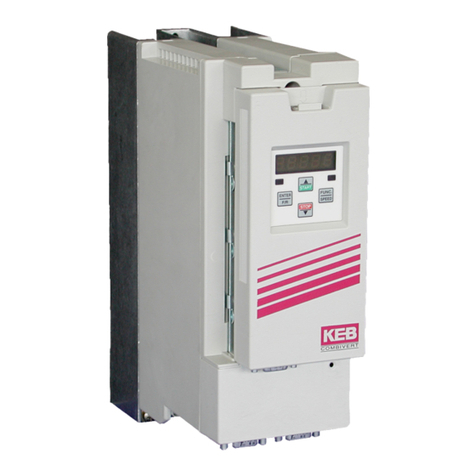
KEBCO
KEBCO COMBIVERT F5 User manual
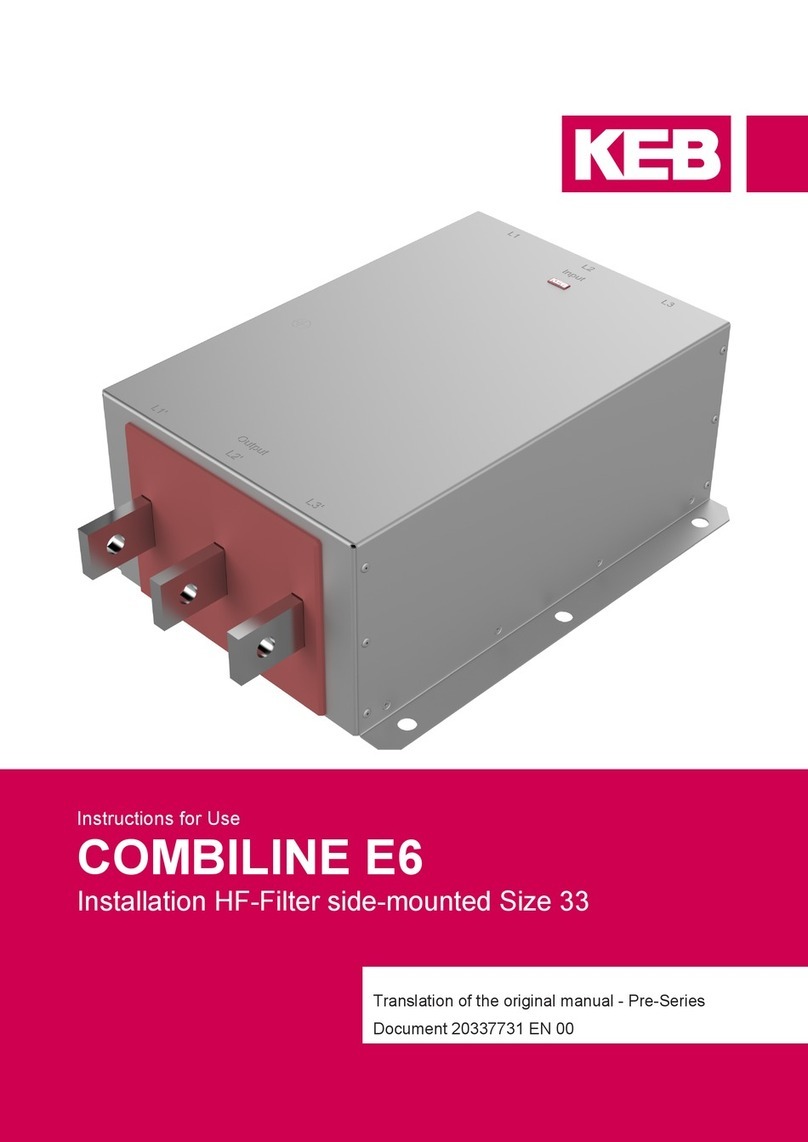
KEBCO
KEBCO COMBILINE E6 Series User manual
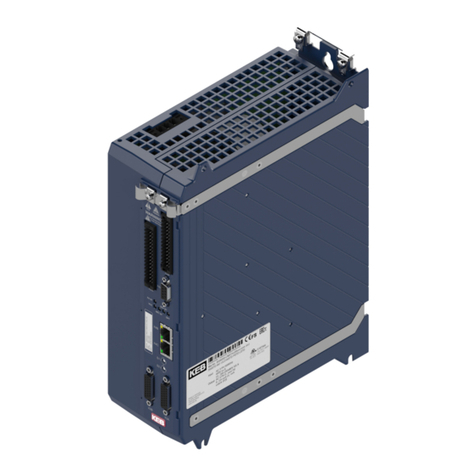
KEBCO
KEBCO COMBIVERT S6 Series User manual
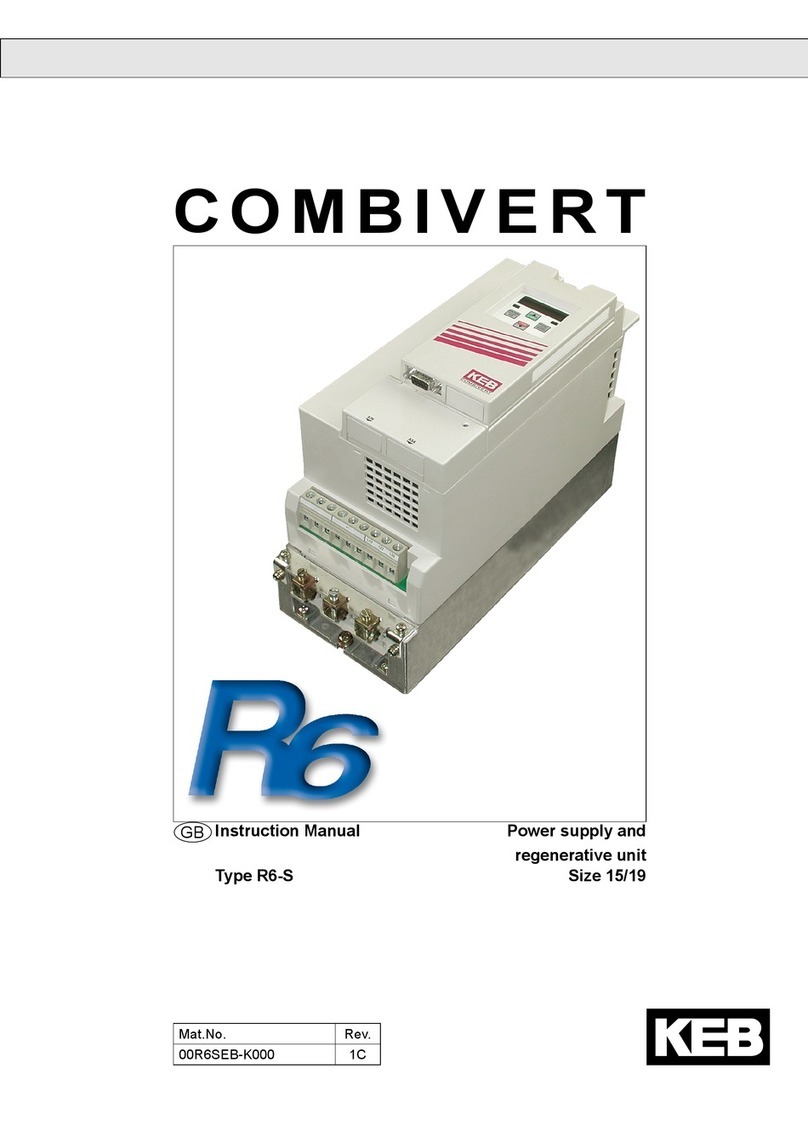
KEBCO
KEBCO Combivert R6 User manual
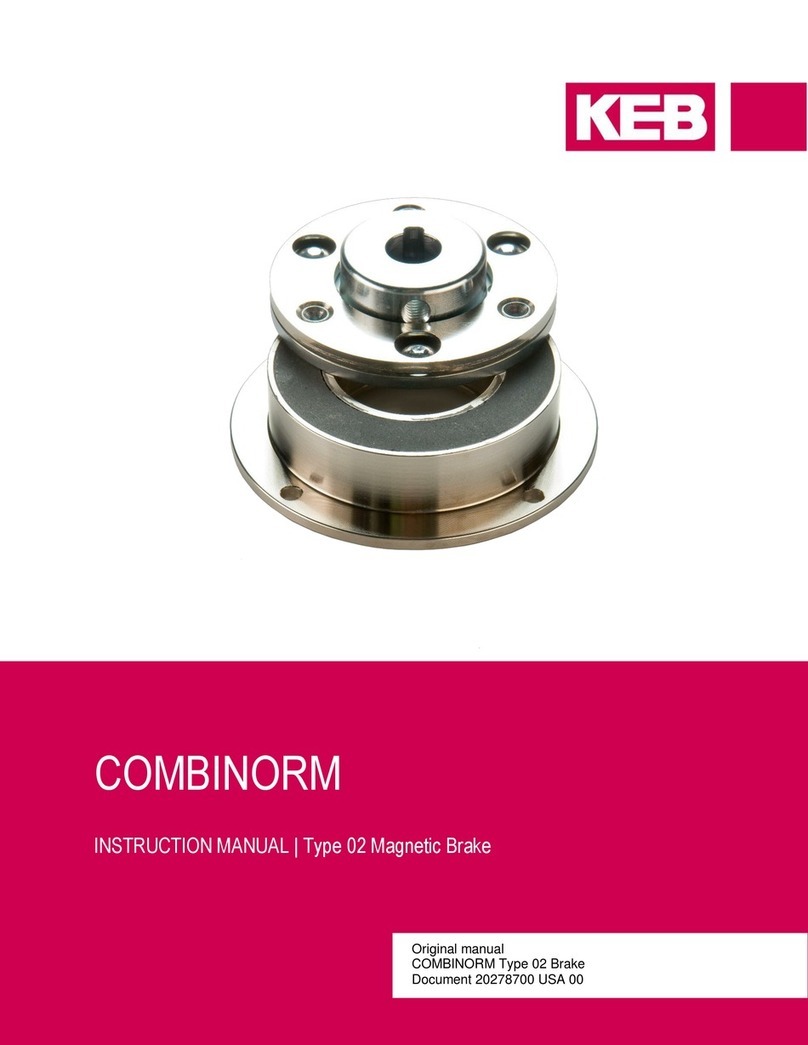
KEBCO
KEBCO COMBINORM User manual
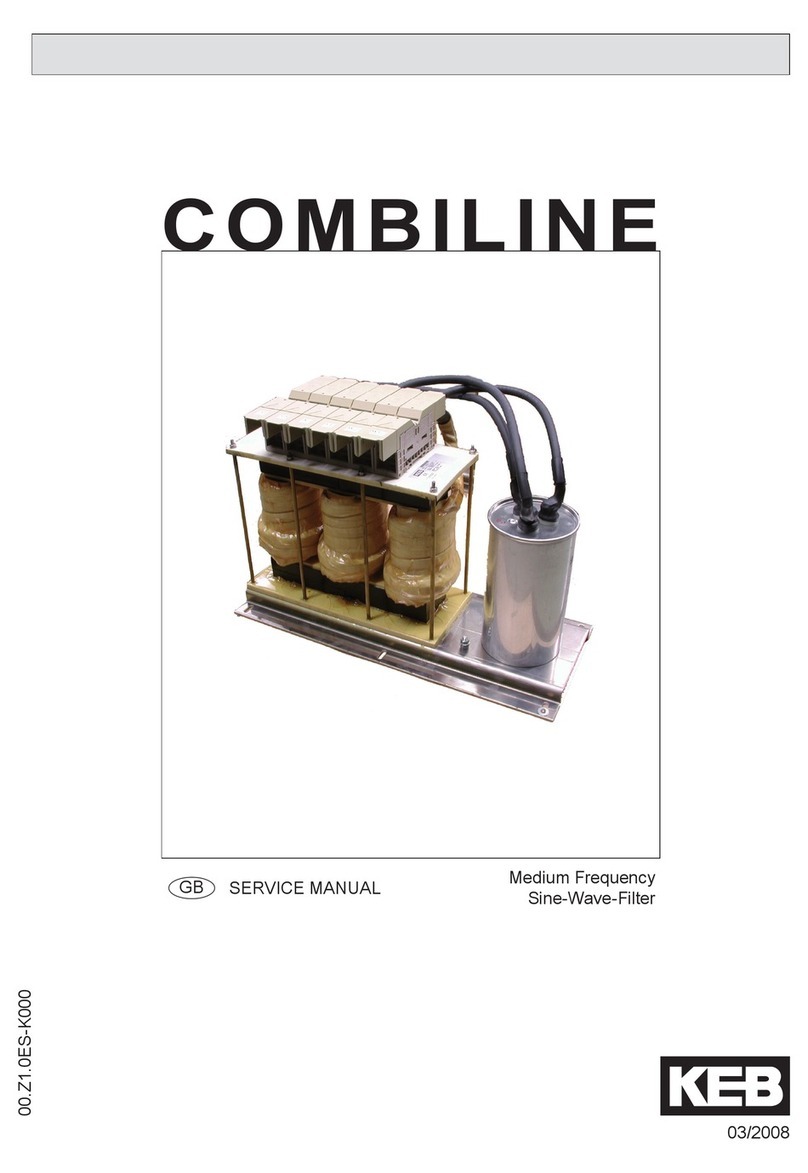
KEBCO
KEBCO COMBILINE User manual
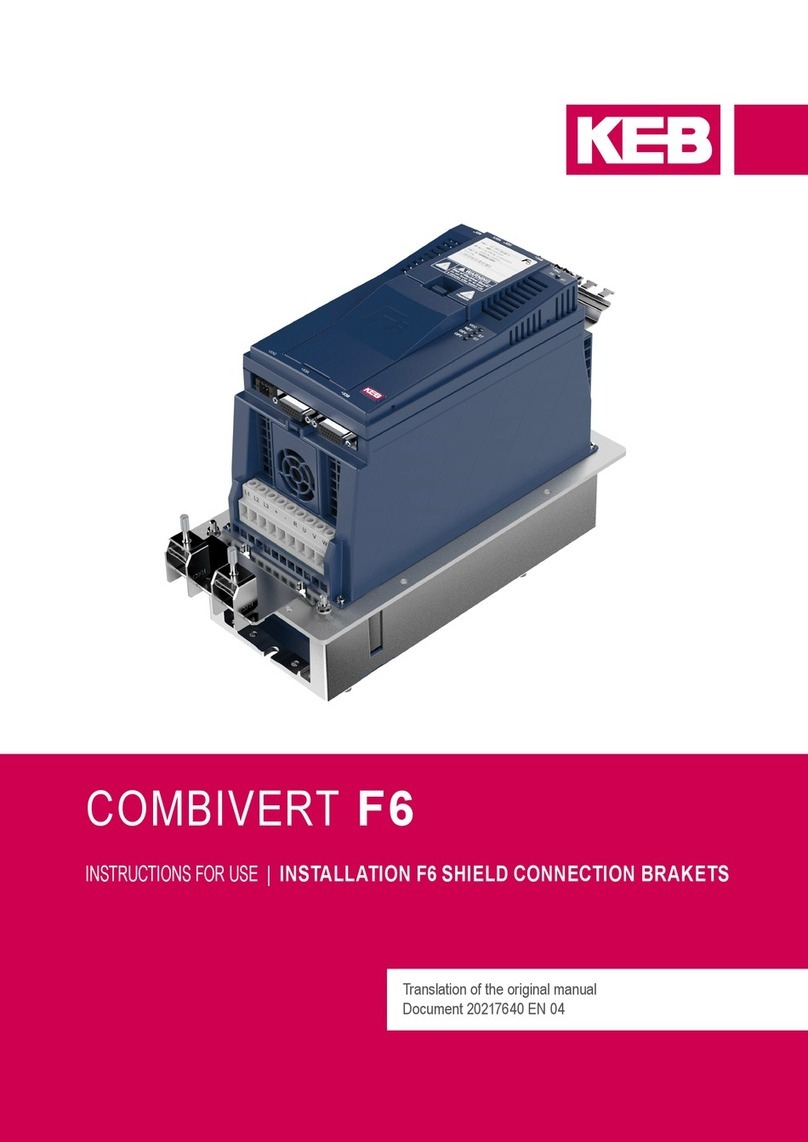
KEBCO
KEBCO COMBIVERT F6 User manual
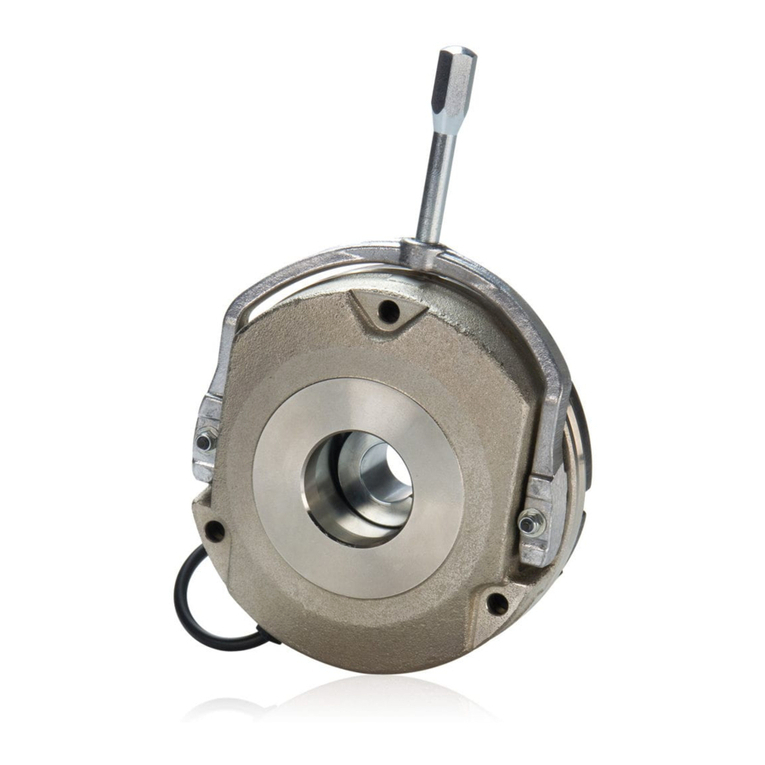
KEBCO
KEBCO COMBISTOP User manual
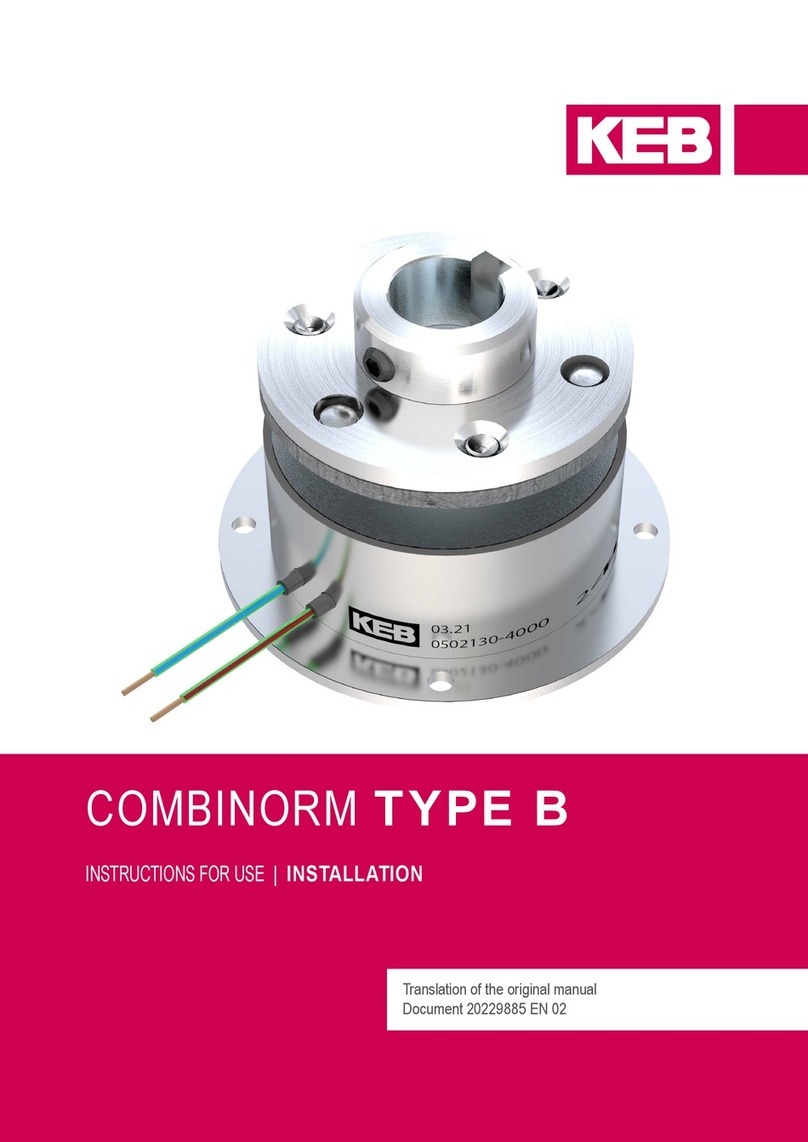
KEBCO
KEBCO COMBINORM B User manual
